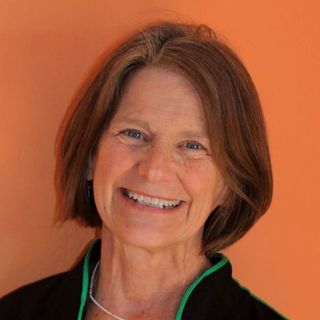
14 Jul Telluride Yoga Fest: Nancy Stechert Returns To Teach at 11th Annual Gathering
The 11th annual Telluride Yoga Festival, Thursday, July 19 – Sunday, July 22, features internationally renowned yoga instructors and leaders in the fields of health & wellness, among them, returning presenter, senior Iyengar instructor Nancy Stechert.
New this year: four 1/2 day Thursday immersions, 9 a.m. – noon; 1 – 4 p.m. To purchase tickets or to learn more about the weekend, the lineup and the schedule, visit here.
Please scroll down to listen to a podcast featuring Nancy Stechert.

Senior Iyengar yoga instructor Nancy Stechert.
Once a child of the East, yoga is now a world citizen, whose teachings transcend cultural, racial and religious barriers.
In America, yoga is Big Business: current estimates are that close to 40 million people are practicing in this country what is now an industry with sales close to $16+ billion a year.
Yoga is also a story of assimilation of centuries-old spiritual disciplines associated with meditative practices in Buddhism and Hinduism into diverse practices subscribed to by professional athletes, CEOs, Hollywood stars and soccer moms. Literally and metaphorically the diversity of yoga experiences offered across this country could leave a person standing on his head: for many, the art and science of yoga is an exacting physical and spiritual discipline, a journey inward that leads to an ineffable described as “enlightenment.” For others, getting on a mat is simply a hip way to stay fit and reduce stress.
But for almost all practitioners, the yoga journey begins with with the discipline of body, breath and mind known as asana practice, which, at its most basic level involves consciously moving the body led by the breath into specific postures. In fact, the Sanskrit word “asana” derives from the verbal root “as,” meaning “to sit or “to be present” and in a yoga context, means “to be established in a particular posture.”
And because many of the forms of asana were precisely defined in the classic texts of Hatha yoga, each pose is characterized by certain key objectives: physical, physiological and emotional. Knowing that, however, it is also important to remember that asana evolved as an integral part of a comprehensive spiritual practice oriented towards personal transformation through a journey inward.
At the Telluride Yoga Festival, senior Iyengar instructor and popular returning presenter Nancy Stechert is teaching three classes, two focused on movement in very specific directions and one on a particular asana long associated with meditation.
Stechert’s Friday class, 1 p.m.,”Surrender Yourself to Forward Extension,” explores forward bends.
From a bio-mechanical perspective, the primary function of forward bends is to stretch the structures of the lumbo-sacral spine. The secondary objectives of forward bending is to stretch the posterior structures of the upper back, shoulder girdle and neck.
Energetically, forward bending is langhana or cooling and calming versus moves like back bending, which are brahmana or energizing. Forward bends are initiated with the exhale.
Stechert describes the practice this way:
“The hips, the hamstrings, the spine, the waist, the neck the EGO! How can I ever surrender peacefully with Santosha, when so many things are calling my attention? We will explore how to release to the simple, but challenging forward extension to be at peace with what is.”
Twists are also langhana. They allow the nervous system to see things from a different perspective.
From a biomechanical vantage point, twisting postures create rotation between the vertebral bodies of the spine, building strength and flexibility in the deep and superficial spinal and abdominal muscles. while maintaining elasticity of the intervertebral discs and ligaments.
Physiologically by simultaneously compressing and stretching each hemisphere of the chest, the mid-torso and intestines, twisting stimulates and enhances respiratory, circulatory and digestive functions. The body’s engine, the diaphragm, also becomes more supples through twisting.
Stechert’s Sunday class, 8 a.m., is titled “Twisting: A Spine That Can Not Revolve. Can Not Evolve.”
The lotus, or padma in Sanskrit, is a powerful symbol that transcends time and religion. Over the centuries, the flower has symbolized a whole span of states, including enlightenment, detachment, cosmic renewal and rebirth, purity, beauty, and spiritual and material wealth.
On Saturday, 1 pm., Stechert shifts the focus to Padmasana or Lotus Pose or “How to Free the Knees!”
Lotus Post is said to increase circulation in the lumbar spine, nourish and tone the abdominal organs, strengthen the ankles and legs and increase flexibility in the hips. But like forward bends and twists, padmasana has the power to settle the nerves and quiet the mind, making it a great pose for a seated meditation.
Nancy Stechert has a theme going here.
To learn more, press the play button and listen to an interview with Nancy Stechert.
More about Nancy Stechert:

Nancy Crum Stechert began Transcendental Meditation with Maharishi Mahesh Yogi in 1971.
She began asana practice in 1976 and made her first trip to India to study with BKS Iyengar in 1983.
Stechert has continued her studies at the Iyengar Institute in Pune almost yearly ever since.
She is founder of the Colorado Iyengar School of Yoga, in Denver, CO. the International Yoga Center of Tokyo, and the Yoga Tree in Hotchkiss, Colorado where she now lives and teaches.
Nancy Stechert holds a Senior Intermediate certificate from BKS Iyengar, conducts teacher trainings and workshops around the world.
Her teaching is exacting, yet subtle and filled with a lightness and humor that gives grace to her classes.


Sorry, the comment form is closed at this time.